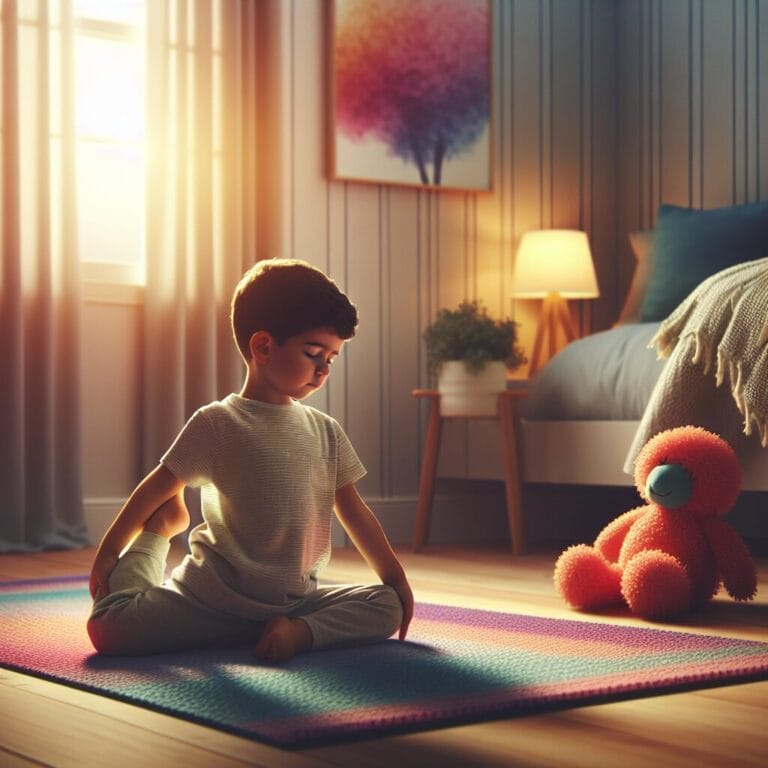
Maximizing Rest: Sleep Optimization Tips for School-Age Children Balancing Student Life
Table of Contents
- Introduction
- Understanding Sleep Needs
- Creating a Sleep-Friendly Environment
- Nutrition and Exercise
- Stress Management and Relaxation Techniques
- Managing Academic and Social Commitments
- The Role of Naps
- Seeking Professional Help
- Conclusion
- Frequently Asked Questions
Introduction
Hey there, parents! Let’s dive into a sleep secret that might just be the game-changer for your kiddo’s zzz’s and A’s. You see, getting enough shut-eye is like giving their brains a superpower boost! It’s not just about sticking to bedtimes; it’s about making those snooze hours as comfy and cozy as can be.
Now, imagine your child snuggled up in a bed that feels like a cloud – we’re talking memory foam or hybrid mattress levels of comfort here. And let’s not forget the pillows! Neck pain pillows for the little dreamers who curl up on their sides or even speciality bedding like bamboo sheets that keep them cool as a cucumber all night long.
But hold up, before they hit the hay, make sure they’re winding down without any sneaky blue light from electronics that could trick their brain into thinking it’s daytime – no way we want that! Instead, how about some chill time with books or quiet games an hour before lights out? That’s the ticket to dreamland!
And hey, if your child tosses and turns more than a pancake at breakfast, take a closer look at their bedtime accessories. Could it be time for an upgrade to an adjustable bed frame or perhaps a cooling mattress pad to battle those night sweats?
Remember, each kiddo is unique—some might need earplugs or white noise machines (goodbye scary silence!), while others might find bliss under weighted blankets. Plus, dodge those late-afternoon caffeinated drinks like they’re dodgeballs in gym class! Ditching caffeine is key since we don’t want them bouncing off the walls when they should be snoozing.
Lastly, if you’re puzzled by pausing playtime for bedtime routines or wondering how many winks are right for your young Einstein – fret not. There’s plenty of sleep science goodness waiting to help you craft their ultimate sleep improvement plan.
So there you have it—tuck these tips under your pillow and watch your little learner thrive with every sleep-filled night!
Understanding Sleep Needs
Did you know that kids aged 6 to 13 need about 9 to 11 hours of sleep every night? That’s right! When young scholars clock in the scientifically recommended snooze time, their brains and bodies get a first-class ticket to Healthyville. Sticking to these sleep guidelines is essential because when they skimp on slumber, it’s like trying to run a marathon with a backpack full of bricks—hard and not fun!
Quality sleep is super important for children’s learning adventures—it’s when their brain files away all the new stuff they’ve learned during the day. It’s like having an invisible helper inside their heads sorting schoolwork into tidy little drawers while they dream. This neat storage trick means come morning; they’re ready to soak up more knowledge without last week’s spelling words getting in the way.
Sometimes, though, our little learners might have trouble catching those much-needed Zs. If your kiddo is more yawny than usual, super grumpy for no reason (watch out!), or can’t seem to recall where they put their homework more often than not, these might be SOS signals from Sleepy Town! And oh boy, ignoring these signs can lead to the sneaky creep of sleep deprivation. Long-term effects are no picnic—they can mess up mood swings worse than a rollercoaster and leave learning abilities feeling sluggish.
So what can we do? First things first—create a cozy sleep environment with just-right beds and bedding. A memory foam mattress or hybrid mattress could hug them just right throughout the night. Cooling sheets bamboo style? Perfect for keeping mini furnaces cool as cucumbers as they drift off. And don’t forget firm pillows for back sleepers or squishy ones for side snoozers!
Bedroom accessories matter too—consider dark curtains and maybe a white noise machine if outside noises are invading their sweet dreams territory. For those bedtime battles with sweaty nights, how about adding a cooling mattress pad into the mix?
And here’s one magical tip: make bedtime routines regular like clockwork—same bedtimes every night—and set wake times even on weekends (sorry kids!). Ditch electronics well before bedtime since blue light shenanigans tell our brains it’s party time rather than pillow time.
Remember, each young learner has a unique ‘sleep profile’ which might mean tweaking bedtime tools and products until you hit that perfect sleepy sweet spot—whether it’s using melatonin supplements wisely or setting up an anti-snoring device arsenal for peaceful nights.
Getting enough quality slumber isn’t just child’s play—it’s crucial building blocks for growing great minds and healthy habits that last lifetimes! Let’s raise our glasses (of warm milk) to helping parents establish healthy sleep habits so youngsters can truly thrive at home and school alike!
Creating a Sleep-Friendly Environment
Sleep isn’t just a nighttime break for busy bodies; it’s a super-charged recharge for brainy bits, too! School-aged whiz kids are like sponges soaking up facts and skills all day long, and guess what? Sleep is their secret tool to glue all that learning in place. Pssst, did you hear about the sleep calculator? It’s this nifty gadget that helps figure out the perfect bedtime based on wake times. Now, that’s tech working for some sweet dreams!
Whipping up a snooze-friendly sanctuary can work wonders for young dreamers. Start with the throne of slumber—the mattress! Whether you go for a firm mattress or one of those cloud-like memory foam varieties depends on your sleeper type. Side sleepers might want something softer to cradle their hips and shoulders, while back sleepers could benefit from extra support to keep those spines nice and straight.
Now, let’s talk sheets—cooling sheets or bamboo sheets can be real game changers, especially if your kiddo runs hot at night. They wick away moisture and keep things breezy so they can drift off without turning into little toaster ovens. And pillows? Neck pain pillows are crucial for avoiding cricks and creaks come morning.
Don’t let electronics be party crashers in Dreamland! Blue light emitted by screens can mess with circadian rhythms big time, tricking brains into thinking it’s still playtime when it’s really sleepy time. A pro tip: set an electronics curfew—a good hour before bed should do the trick—and swap gadgets out for books or other low-key activities to help wind down.
A surprising nugget of wisdom comes from sleep medicine experts who say zzz’s affect everything from school performance to dodgeball domination (okay maybe not dodgeball specifically). So make sure there’s no sneaky sip of soda with dinner—caffeinated beverages after lunchtime are a no-no if we’re aiming for top-notch slumber.
On weekends and holidays, try sticking close to the regular sleep schedule because consistency is key. Sure, sleeping in feels great but zigzagging bedtimes can have little learners feeling like they’re in different time zones every Monday!
By helping parents establish healthy sleep habits—like keeping rooms dark and quiet with the right bedding weighted blankets or comforters—it becomes easier to tuck kiddos in without bedtime turning into negotiation time.
So here’s our ultimate sleep improvement plan: create comfy bedrooms with thoughtful accessories (hello cool mattress pads!), protect against blue light baddies before bed, avoid daytime drowsy drinks (that means you caffeine), and zoom towards regular wake times—even when cartoons beckon on Saturday mornings! This way we’re not just dreaming about success; we’re resting up to reach it!
| Aspect | Details | Tips |
|---|---|---|
| Bedtime Calculation | Sleep Calculator Tool | Helps determine perfect bedtime based on wake times. |
| Bed Type | Mattress Selection | Choose firm for back sleepers and soft for side sleepers. |
| Sheets | Cooling Sheets, Bamboo Sheets | Wicks away moisture, keeps sleeper cool. |
| Pillows | Neck Pain Pillows | Prevent neck cricks and ensure comfort. |
| Electronics | Blue Light Exposure | Set an electronics curfew one hour before bedtime. |
| Diet | Caffeinated Beverages | Avoid caffeine after lunch to ensure better sleep. |
| Sleep Schedule | Consistency | Stick to regular sleep times, even on weekends and holidays. |
| Sleep Environment | Dark, Quiet Rooms | Use the right bedding, weighted blankets or comforters. |
| Bedroom Accessories | Comfort Items | Invest in cool mattress pads and other comfy accessories. |
| Blue Light Protection | Before Bedtime | Protect against blue light with special glasses or screen settings. |
| Drinks | Daytime Alertness | Avoid drowsy-inducing drinks during the day. |
| Wake Times | Regular Schedule | Maintain consistent wake times for better sleep rhythm. |
Nutrition and Exercise
Giddy up for a snooze-tastic revelation, little stars and their superstar parents! Did you know the snacks and sippies we gobble up can play hide-and-seek with our sleepiness? That’s right—munching on the right eats before beddy-bye could send us zooming to dreamland faster than a comet! Now, picture this: It’s snack o’clock, but instead of reaching for sugary treats or sneaky caffeine-loaded drinks that keep our peepers wide open like an owl’s, we grab a banana or sip some warm milk. These goodies are like lullabies for our tummies!
And here’s another slice of sleepy pie – Workout warriors in training (yup, that means you, kiddo athletes!) might find jumping jacks and fun runs do more than just make muscles mighty. Getting active makes Mr. Sandman’s job way easier when it’s time to tuck in. But timing is key—it’s not about sweating buckets right before bed; that’d be like having a dance party at lights-out! Better to get those kicks and cartwheels done earlier so bodies can chillax into sleep mode.
Now let’s give a high-five to foods that are pals with pillow land—think cherries (yum!), which have natural melatonin to whisper “night-night” to your brain cells. And oats aren’t just tasty; they’re like cozy blankets from the inside out. But look out for villainous vittles lurking around bedtime—anything super spicy or greasy might turn dreams into not-so-fun adventures.
So what’s the secret sauce for sleep-savvy munchkins? Stick to a regular meal schedule where dinner dances around your kitchen table well before twilight hours hit. Then cap off your night with a calm snack if tummies are rumbling—but think sleepy snacks over party-starters!
Remember this ultimate sleep improvement plan combo: early-day exercise plus bedtime-friendly bites equals happy zzz’s! Nighty night, don’t let the bed bugs… wait—they’re just tiny teddies in disguise when your sleep game is strong!
Stress Management and Relaxation Techniques
Did you know that stressed-out kiddos might as well be counting sheep till the cows come home? That’s because when the worry whirlwind hits, it can turn their cozy bed into a wild ride of wakefulness. Now picture this: a little superhero in training, squeezing their favorite plushie, practicing deep belly breaths to save the night! Yep, relaxation techniques are not just for grown-ups. Guided imagery or calming yoga poses can be secret weapons against those pesky stress monsters.
Let’s get our little learners on board with chillaxing habits like crafting or journaling—cool hobbies that put busy brains on snooze mode. Even a simple cuddle session with a storybook can steer them towards dreamy destinations faster than you can say “once upon a time.” And what about adding some soft tunes to the mix? A smooth melody could be just the lullaby they need.
Creating a pre-sleep routine is like setting up an invisible ‘Do Not Disturb’ sign for their snoozing space. This isn’t just about hitting the hay at regular sleep schedule times; it’s a special process that tells their bodies “Hey, it’s almost time to power down!” So slip into pajamas that feel like hugs, enjoy some warm milk (go ahead and pretend it’s cocoa from outer space), and snuggle under bedding weighted blankets designed to feel like comfy cocoons.
But wait—there’s more! Let’s talk about transforming their bedroom into a sleepy sanctuary. We want room vibes that whisper “relax” rather than ones that shout “playtime!” A cool mattress or maybe even memory foam wonders could make all the difference. Ensure there’s no sneaky blue light lurking around from electronics trying to crash the slumber party—that stuff messes with their circadian rhythms big time!
So gear up and make bedtime stress-less and restful by helping young children embrace calming activities before lights out. With these top proven sleep tips tucked in our pockets, we’re setting sail for smoother seas in Sleepy Harbor tonight!

Managing Academic and Social Commitments
Hey there, super students and your sidekick parents! Have you ever felt like there are just not enough hours in the day to juggle homework, soccer practice, piano lessons, AND still score a full night’s sleep? Well, fear not! With some clever time management tricks up our sleeves, we can help our young geniuses balance their busy bees’ schedules with getting the zzz’s they need. It’s all about setting realistic goals – because let’s face it, aiming to be class valedictorian, MVP of the soccer team, and a piano prodigy might be stretching it thinner than a tightrope over Niagara Falls!
Prioritization is key; it’s like being a master juggler who knows which balls to keep in the air and which ones can take a little tumble now and then. Assigning time slots for homework and study sessions makes sure school performance doesn’t slip while keeping an eye on those wake times. And speaking of snooze-land – did you know that even superheroes need downtime? Yep, sprinkling in some chill-out breaks between all the action-packed chapters of daily life isn’t lazy; it’s smart strategy! It helps prevent burnout faster than you can say “power nap.”
So let’s get strategic with cozy sleep settings too—swapping cheap mattresses for something more supportive like memory foam or hybrid wonders could mean fewer tosses and turns. Comfy pillows pillows (yes, they’re doubly important) catered to sleeper type – from neck pain saviors for side snoozers to firm support for back dreamers – are non-negotiable champions of slumber.
And don’t forget those bedroom superheroes: dark curtains that block out every villainous beam of light and white noise machines that shush the world outside. Oh! And one last tip-top proven sleep tip: make room in that packed schedule for regular physical activity—it’s like winding up your inner clock so when bedtime rolls around, falling asleep comes as naturally as breathing.
There you have it—a toolkit brimming with everything from prioritizing powers to bedtime rituals that pave the way for sleep-filled nights. Because savvy scholars know it’s not just about how hard you work or play but how well you rest at the end of an action-stuffed day. So let’s conquer those sleep problems head-on—ensuring our young learners wake up refreshed and ready to tackle all their adventures!
The Role of Naps
Wake time woes? Naps might just be the underrated sidekick in our quest for optimizing sleep in school-age children. Picture this: a midday power-down can turbocharge tiny brains, making after-school homework less of a Herculean task. But here’s the scoop—timing is everything! A catnap too late in the day could mean counting sheep way past bedtime. To keep nighttime winks on point, cap naps at 20-30 minutes; it’s like pressing the refresh button without rebooting the whole system.
For those young scholars who aren’t snoozing solidly through the night, an early afternoon nap might be just what the sleep doctor ordered—think post-lunch but pre-math-test jitters. This sweet spot allows little learners to fall asleep quickly while still ensuring they’re sleepy enough when stars twinkle. Integrating short siestas into their regular sleep schedule can sharpen memory and boost mood better than any caffeinated beverage dare try, minus the tossing and turning side effects!
So, whether it’s snooze-button bliss under bedding weighted blankets or cozy corners with neck pain pillows for those back pain-inducing desks, smart nap strategies are about more than catching Zs. They’re part of a holistic approach to sleep health that keeps circadian rhythms doing their happy dance and our mini-minds sharp as tacks. The ultimate sleep improvement plan for kids isn’t complete without considering how and when these stealthy sleep snatchers fit into their busy days—ensuring every night is goodnight!
Seeking Professional Help
Have you ever wondered if those midnight monster marathons under your kiddo’s bed might actually be something more? When counting sheep turns into counting the cracks in the ceiling, it could be a signal to seek out a sleep specialist. Sleep disorders in children aren’t just about bad dreams; they’re real and can range from insomnia to sleep apnea, each with its own set of sneaky symptoms that do more than just keep them up at night. These disorders can make school days seem longer than a sloth’s to-do list and topple school performance like a house of cards.
Take sleep apnea, for instance—it’s not just an adults-only club. Kids can join too, but instead of snoring logs, they might show signs like waking up tired or having trouble focusing on homework. On the other hand, restless leg syndrome (RLS) wiggles into bedtime routines with tingling sensations in tiny toes that beg for one last dance before dawn. Such conditions not only steal precious Zs but can also sneakily nibble away at self-esteem and learning capabilities.
Here comes the good news: there are treatment options aplenty! From medical interventions like CPAP machines (think superhero masks for sleeping) to behavioral strategies such as consistent routines that fit snugly around wake times—help is at hand. Many parents find comfort in resources like sleep hygiene education and melatonin supplements tailored to suit their child’s unique sleep profile.
So, when little ones toss and turn more than a chef flips pancakes, consider consulting professionals who navigate the sleepy seas of circadian rhythms with ease. With expert guidance and personalized intervention tools—from cool mattress pads that lull back pain to sleep habits as steady as a metronome—young minds can dive into dreamland equipped for success both under the moon and in the classroom sun.

Conclusion
Hey, dynamos of the dream world! Did you know that a cozy cuddle with their favorite plush toy might just be what your youngster needs to sail smoothly into snoozeland? That’s right, comfort objects can act as mighty sleep anchors for young children, giving them the confidence to brave the night solo. But let’s amp up the fun – how about a bedtime treasure hunt? Hide small trinkets under their pillows or around their memory foam mattress (no monsters here!) as rewards for sticking to their sleep schedule. This playful twist turns bedtime into an adventure and makes falling asleep an eagerly awaited quest.
While creating this treasure trove of comforts, don’t skimp on other super sleep supports like hybrid mattresses and cooling mattress pads – they’re the unsung heroes battling back pain and overheating villains. And remember, not all bedding is spun from the same starry fabric; choose sheets cooling enough for little hot water bottles or bamboo sheets whispering tales of faraway forests. Pillows are powerful allies too – neck pain pillows for mini side-sleepers and firmer options for those tiny backs need careful selection.
So let’s wrap up this sleepy saga with a shoutout to parents: You’re the captains steering this ship through night waves, helping establish healthy sleep habits with every tuck-in tactic. From avoiding late-day caffeine capers to enforcing that regular sleep schedule like it’s law in Sleepy Town – you’ve got this! Together with your wide-eyed wonders, embrace these tools and products (don’t forget those helpful CPAP masks if needed) designed by sleep medicine maestros to ensure rest rules supreme!
As we bid goodnight to our slumber chronicles, cherish these top proven sleep tips: craft a consistent routine in a dark, quiet haven decked with snug bed frames adjustable beds aligning with each sleeper type; balance work-play-rest perfectly without teeter-tottering into sleeping problems. After all, at day’s end when stars twinkle secrets across the sky, it’s these moments of peace we weave into our ultimate sleep improvement plan that matter most. Happy dreams!



